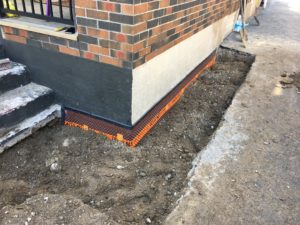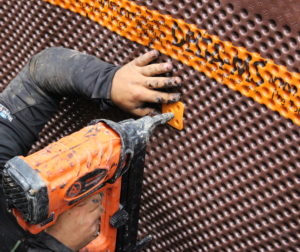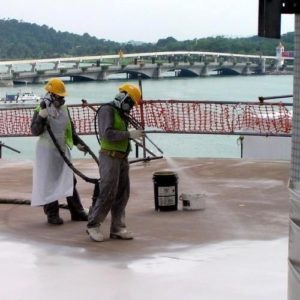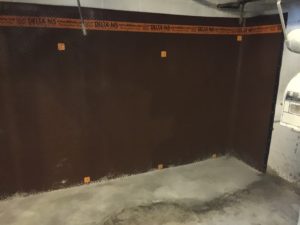Basement ready for winter – ACCL Waterproofing
Basement ready for winter? – ACCL Waterproofing

Many people believe that the rainy season is the worst time of year for a basement. Continuous rain and floods will put your basement’s ability to keep water out of your home to the test. Water leaks and flooding are terrible enough, but the mold growth that will inevitably result is considerably worse.
Unfortunately, if your basement has not been professionally waterproofed, the winter months can flood just as terrible as the rainiest months. When the ground temperature rises above freezing, the snow melts almost rapidly, turning into water and having the same impact as rain. The sticky snow gathers when the ground temperature is below freezing, waiting for the temperature to rise so it may change into a torrent of water.
Water seeps in through the porous surface of cinder and brick as it gathers near your home. A rapid change in temperature can cause the water to freeze, compromising the integrity of your foundation. When the temperature rises, the ice-caused microcracks expand slightly, allowing the confined water to flow more freely into your basement than ever before.
Waterproofing during the winter months is obtainable but can prove to be difficult when snow becomes ice and completely covers the areas of the foundation once that is done a jackhammer will be needed in order to completely remove the suspected area and can be completed in a timely manner before the situation would get any worse
Winter Tips –

Don’t Wait Until Winter to Waterproof Your Basement – If you’re going to hire a professional waterproofing company to waterproof your basement, do it now! Contractors are unable to work outside due to the cold, and digging into the earth is nearly impossible due to the low conditions.
Don’t Pile Snow Against Your House – When it’s time to clear the driveway after a snowfall, don’t pile snow against your house. Snowdrifts are a torrent of water just ready to burst into your home. Ice dams can occur as a result of temperature changes, weakening the walls of your basement.
To Drain Away, Keep Your Gutters Clean. Snow Melting on the Roof – Make sure your gutters are properly directing water away from your home. If water pools near your home’s foundation, it will eventually make its way into your basement. Melting snow water should drain at least 5 feet away from your home or be allowed to run freely away from it.
It’s a good idea to inspect your gutters before winter arrives to make sure they’re clean of leaves and debris from the previous season. This will not only protect your roof and gutters from snow damage, but it will also allow melting snow to run away from your home’s foundation.
Check that your sump pump hose does not have any low locations where water can gather throughout the winter. The discharge should be able to easily flow away from your residence. If the water freezes and gathers, the sump will most likely stop working or potentially cause irreversible damage to the device.
Take advantage of the warmer summer months to have us look at your basement and help you determine how best to address your basement leakage problems.

Get the job done RIGHT – Hire a professional Waterproofing company!
Want to know more about our waterproofing process? Give us a call at 416-759-2995
Rely On our ACCL Wet Basement Waterproofing Experts
Don’t Drown in a wet basement!
Rely On Wet Basement Waterproofing Experts
If you’ve noticed foundation cracks, spots, water, mold, and mildew, don’t ignore the signs or it could lead to more damage and possible health effects.
The basement waterproofing specialists at ACCL Waterproofing know how to repair your basement and foundation walls and keep moisture out of your basement. We would be pleased to develop a guaranteed solution to keep your basement dry!
Rod Leaks: ACCL Waterproofing
Rod Leaks: ACCL Waterproofing
If water gets into your basement, it can cause irreversible damage and render the space useless. Tie rod leaks, which are small holes in your foundations that can let water in, are one of the easiest problems to repair but also a very common port of entry for leaky basements.
With our entire selection of professional solutions, Direct Waterproofing can help you cure any and all basement and foundation damp problems.
Tie rods are short steel rods used to hold forms together during the construction of your home so that concrete can be poured. When the concrete is poured, the rods are removed, leaving weak points of entry where water can eventually make its way into your home.
What Should You Be Aware Of?
Most homes are built with tie rods, however some more modern homes employ snap ties, which do not have the same issue. If your home’s foundations have holes caused by tie rods, it’s usually a good idea to get them repaired, especially if water damage begins to appear.
If your tie rod holes are leaking, you may notice a little stain on the inside of your basement walls the size of a dime, or a water line that runs all the way down to the floor. Water can pool or flood your basement if the leak is significant. A wall normally has between 5 and 8 tie rods, and it will be the external walls that you are concerned with. As a result, water damage may emerge in orderly lines where the tie rods used to be.
What Causes This to Happen?
Small metal rods called tie rods are put into the concrete form during the initial building of many homes to hold the inner and outer forms together and give the structure with which the concrete can be poured. They are spaced around 18 inches apart, occasionally in two rows.
They are normally removed fully after construction, leaving a hole. The builders may attempt to hide the tie rod holes with hydraulic cement and a coating, at least visually, but this might wear off over time, revealing a particularly vulnerable spot for water to enter. Given that the tie rod holes are essentially hollow all the way through, water will always seek the path of least resistance and flow through them if possible. This is why the issue is so widespread. If water gets through, it will inevitably end up in your basement!
What Options Do You Have?
In the event of tie rod hole leaks, Direct Waterproofing has a variety of options available, and we can handle a single leaking tie hole or a whole wall of them. The job is usually simple and inexpensive, and it entails the careful administration of a high-grade sealant injection, also known as a swell plug, to fill and cement the hole.
If there are more serious problems, we can look into providing permanent interior or exterior waterproofing solutions to ensure that water never gets into your basement again.
What are Tie Rod Holes, and what do they do?
Tie rod holes are typically drilled into a foundation wall. The concrete foundation is reinforced with smooth steel rods. The rods keep the concrete forms from bulging under the weight of wet concrete. The tie rods are inserted between the concrete forms. Even under the great pressure of the wet concrete filling the forms to produce foundation walls, the concrete forms do not expand outward with the rods in place. The wet concrete pours over and around the tie rods as it is poured. The builders remove the tie rods once the concrete cures, leaving tiny holes known as tie rod holes.
Contractors usually fill the tie rod holes with hydraulic cement or another suitable material after removing the tie rods. Freeze-thaw cycles and ground movement, on the other hand, may cause the patching work to wear out over time. When groundwater seeps into the basement through the gaps in the foundation walls, this could cause problems. The tie rod holes have no bearing on your building’s overall strength and stability. They may, however, result in leaks in the basement and foundations.
Tie rod openings are very common in older homes. If you discover water stains or tiny holes where water is pouring or seeping through, you should act quickly. A leaking water line to the floor is another common sign. Water may pool in the basement or even create floods in extreme circumstances. Professional tie rod hole repair is recommended. To avoid the problem reoccurring, get the holes repaired by a skilled and reliable waterproofing contractor.
Take advantage of the warmer summer months to have us look at your basement and help you determine how best to address your basement leakage problems.

Get the job done RIGHT – Hire a professional Waterproofing company!
Want to know more about our waterproofing process? Give us a call at 416-759-2995
Rely On our ACCL Wet Basement Waterproofing Experts
Don’t Drown in a wet basement!
Rely On Wet Basement Waterproofing Experts
If you’ve noticed foundation cracks, spots, water, mold, and mildew, don’t ignore the signs or it could lead to more damage and possible health effects.
The basement waterproofing specialists at ACCL Waterproofing know how to repair your basement and foundation walls and keep moisture out of your basement. We would be pleased to develop a guaranteed solution to keep your basement dry!
What is Basement Parging, and how does it work? – ACCL Waterproofing
What is Basement Parging, and how does it work?
Basement parging is frequently thought of as an afterthought that completes the appearance of a home’s façade. While decorative parging can improve the appearance of any drab-looking home, old or new, it also adds an extra layer of foundation protection. However, many homeowners are unaware of what parging is and why it is so vital for keeping your home dry.
Basement Parging Isn’t Just A Strange Word
Parging is a strange-sounding word, and many homeowners don’t know what it means, thinking it’s just another aspect of the structure. Parging is a mortar that is placed to both the inside and outside of the foundation to protect the brickwork from the elements.
Because it looks so much nicer than the materials used to construct the foundation, you’ll see it at the foundation level more commonly than bare concrete. As a result, parging is frequently dismissed as just cosmetic, serving to conceal flaws and unsightly aspects of brickwork.
This isn’t always the case, though! While parging is not waterproofing and should not be considered a sufficient barrier in and of itself, it can play a significant role in the waterproofing of your property. When correctly sprayed, parge coatings can protect the foundation walls that rise above the earth from rain and snow.
Basement Parging and a Proper Foundation
If a parge coat is to function well as a barrier, it must be applied correctly. The foundation surface and the material must be prepared before parging:
- The surface must be damp and stain-free.
- The surface must be smooth and free of brittle or cracking areas.
- The parging must be prepared according to the manufacturer’s specifications, using the correct application and curing temperatures.
- While the substance cures, it must be moisturized.
- Any cracks or damage should be fixed as soon as possible to prevent moisture ingress.
- If the parging has been severely damaged, the previous coat should be scraped and a new coat applied.
Spray the parging with a little water over the next day or two to slow the drying process and prevent it from cracking or peeling. To add more colour to your home’s exterior, paint the foundation parging once it has dried: clean the surface, apply the appropriate primer for the paint, and then roll on two or three coats. If there is no parging on the foundation, don’t paint it since moisture can get behind the layers of paint and destroy the concrete.
While homeowners can parge their homes, it’s critical that it’s done correctly. Water can penetrate between the parge coat and the concrete foundation when parging is applied incorrectly, creating the moisture damage you were wanting to avoid in the first place.
It can also cause “spalling,” or the degradation and fragmentation of concrete. If your home need parging repairs or a whole new layer, contact a drainage and waterproofing professional in your area.
Take advantage of the warmer summer months to have us look at your basement and help you determine how best to address your basement leakage problems.

Get the job done RIGHT – Hire a professional Waterproofing company!
Want to know more about our waterproofing process? Give us a call at 416-759-2995
Rely On our ACCL Wet Basement Waterproofing Experts
Don’t Drown in a wet basement!
Rely On Wet Basement Waterproofing Experts
If you’ve noticed foundation cracks, spots, water, mold, and mildew, don’t ignore the signs or it could lead to more damage and possible health effects.
The basement waterproofing specialists at ACCL Waterproofing know how to repair your basement and foundation walls and keep moisture out of your basement. We would be pleased to develop a guaranteed solution to keep your basement dry!
Controlling Dust and Debris: ACCL Waterproofing
Controlling Dust and Debris: ACCL Waterproofing
Is it required to use Dust Suppression?
Absolutely, and for a variety of reasons. Dust suppression becomes a major concern while removing concrete with a jackhammer. the jackhammer’s repeated motion tears down concrete and creates a fine dust particle. This dust is easily airborne and can go a long distance, causing a huge mess. It’s nearly hard to clean everything up completely.
How can we keep the dust at bay?
The EnviroBoot contact person. This boot is attached to a heavy duty HEPA level filtration vacuum cleaner and fits over the jackhammer’s housing. The dust is quickly suctioned up at the point of contact and into the HEPA vacuum as the jackhammer creates it.
Lime Dust –
This airborne particulate is hazardous to one’s health. Sand, stone, and lime are the main components of concrete. Concrete is mostly made up of lime (and there is a lot of lime in concrete). It’s the glue that holds sand and stone together, yet it’s also highly poisonous to human tissue. The small particulate’s airborne nature makes it simple to inhale lime dust, posing a health risk to everyone living in the residence. It irritates the eyes and inflames the sinuses, therefore contact should be kept to a minimum. ACCL Waterproofing goes to great lengths to avoid this issue.
Containment of Dust in the entire room –
In the center of the basement, a negative air machine is put up. Through a huge HEPA filter, it pulls a significant amount of air from all directions. Even though the air that passes through the filter is perfectly clean, we nevertheless vent it outside. We vent outside to keep any air movement in the basement to a minimum. This method is exceptionally effective and results in a completely dust-free installation.
In the end, it’s all about safeguarding one of your most valuable assets: your home. We understand how critical it is to hire the appropriate personnel who will deliver the results you need at the right price. We have a long list of satisfied customers who can speak to our honesty and trustworthiness. Invite us to provide you with a free examination and quotation right now.
Take advantage of the warmer summer months to have us look at your basement and help you determine how best to address your basement leakage problems.

Get the job done RIGHT – Hire a professional Waterproofing company!
Want to know more about our waterproofing process? Give us a call at 416-759-2995
Rely On our ACCL Wet Basement Waterproofing Experts
Don’t Drown in a wet basement!
Rely On Wet Basement Waterproofing Experts
If you’ve noticed foundation cracks, spots, water, mold, and mildew, don’t ignore the signs or it could lead to more damage and possible health effects.
The basement waterproofing specialists at ACCL Waterproofing know how to repair your basement and foundation walls and keep moisture out of your basement. We would be pleased to develop a guaranteed solution to keep your basement dry!
Waterproofing Exterior Walls 101 – ACCL Waterproofing
WATERPROOFING EXTERIOR WALLS 101
Water and moisture can move through the brickwork and impact your internal walls when outside walls are exposed to rains or high humidity. This implies that your walls may remain damp for an extended period of time before drying, perhaps resulting in mold development and irreversible damage. In humid climates, wall damage from water penetration is a matter of when and not if.
How can you keep your walls safe from water and mold? To waterproof exterior walls, perform the next seven procedures.
LOOK FOR FAUCETS ON THE WALLS
Only if the walls get damp as a consequence of rainwater or moisture is waterproofing external walls the best solution. It’s critical to rule out any other reasons of structural dampness before looking for waterproofing goods. Anything from cracks in your brickwork to humidity within the wall to a busted water pipe could be the cause. You can use a professional as a preventative step once you’ve fixed the problem.
MAKE SURE GUTTERS ARE CLEAN
Clogged gutters cause a number of issues, including rotten wood, leaks, and mold. They also collect rainwater, which is progressively absorbed by the roof’s wood or fascia boards, potentially leading to a number of issues such as rotten wood, leaks, and mold. By cleaning your gutters twice a year, you may avoid all of these problems and keep your home healthy.
CHOOSING THE RIGHT WATERPROOFING TECHNIQUE
To help homeowners protect their homes from external moisture, a variety of waterproofing materials are now available. Here are a few products to think about:
- concrete waterproofing coating, a cement-like solution that clings permanently to concrete and masonry; it can be applied to any surface, including painted walls.
- a silicate-based concrete sealer that forms a waterproofing layer by reacting with the components in masonry and concrete; this sealer can only be used on unsealed/unpainted walls.
- waterproofing paint is identical to acrylic wall paint, with the exception that it performs better in terms of waterproofing. It’s critical to select a breathable formulation that’s designed to allow walls to breathe and expel moisture. The product can be used on already painted surfaces.
EMPLOY A WATERPROOFING ADDITIVE IN THE PLASTER
Plastering can help improve the look of a room, make it more substantial, and keep moisture out. Although most external plasters have waterproofing properties, by simply adding a waterproofing additive to the plaster, you may solve water penetration problems and prevent reoccurrence.
GET YOUR WALLS READY FOR WATERPROOFING
Whatever product you use for waterproofing exterior walls, you must first get your walls in good shape. To fix cracks and patch holes, you’ll need to utilize a high-quality filler. Allow enough time for the filler to dry completely before grinding. To guarantee a proper adhesion between the waterproofer and the substrate, sand away rough, uneven parts, rinse the surface with water to eliminate dust, and let the walls dry fully.
PUT THE WATERPROOFER ON
The waterproofer can be applied using a roller or a brush. If a second coat is required, let the first coat dry completely before applying the second. Enough substance should be used to provide an impenetrable barrier to penetration.
WATER-TIGHTNESS TEST
It’s critical to do a water-tightness test to determine the performance of the products used to waterproof exterior walls. Water should be sprayed on the wall surface for a couple of hours with the nozzle set at a 30-degree angle for this test. Only if a moisture meter indicates that there is no dampness in your home will it pass the test. You’ll not only avoid major damage but also increase the value of your property by waterproofing exterior walls.
Take advantage of the warmer summer months to have us look at your basement and help you determine how best to address your basement leakage problems.

Get the job done RIGHT – Hire a professional Waterproofing company!
Want to know more about our waterproofing process? Give us a call at 416-759-2995
Rely On our ACCL Wet Basement Waterproofing Experts
Don’t Drown in a wet basement!
Rely On Wet Basement Waterproofing Experts
If you’ve noticed foundation cracks, spots, water, mold, and mildew, don’t ignore the signs or it could lead to more damage and possible health effects.
The basement waterproofing specialists at ACCL Waterproofing know how to repair your basement and foundation walls and keep moisture out of your basement. We would be pleased to develop a guaranteed solution to keep your basement dry!
Waterproofing Concrete: ACCL Waterproofing
Waterproofing Concrete: ACCL Waterproofing
You can waterproof concrete from the positive (external) side, negative (internal) side, or from within the concrete itself to make it truly waterproof—that is, to prevent water passage while also resisting hydrostatic pressure (integral systems). Although sheet membrane waterproofing is the most extensively utilized positive-side method, breakdowns and restrictions are widespread and costly.
It’s challenging to keep up with advances in membranes and crystalline admixtures, and both technologies have seen significant developments. Here’s a quick rundown to help you make your decision.
Membrane Sheet Systems

A sheet membrane made of polymer components combined with asphalt and adhered to a polyethylene sheet is known as cold-applied polymer-modified bitumen. When compared to asphalt alone, the polymer is merged with the asphalt to generate a more viscous and less temperature-sensitive elastic material. These self-adhering sheets are free of the hazardous chemicals linked with asphalt adhesion. They also boost tensile strength, acid resistance, resilience, self-healing, and bonding ability.
Despite these developments, there are still drawbacks. Membranes require sealing, lapping, and finishing of seams at the corners, edges, and between sheets, which can be difficult to do. Sheet membranes must also be applied with a smooth finish that is free of cavities, honeycombs, and protrusions. Protection boards must be installed since the membrane can puncture and rip during backfilling.
Despite these disadvantages, sheet membranes have been the industry standard in waterproofing for many years and continue to dominate the market. Impact resistance, hardness, and overall longevity are reasons for their continued use when compared to other membrane solutions.
Membranes that are treated with liquid
Liquid-applied membranes are commonly made up of urethane or polymeric asphalt (hot or cold-applied) in a solvent base and can be applied with a brush, spray, roller, trowel, or squeegee. These membranes, which have high elastomeric qualities, are frequently put to the positive side of cured concrete. Negative-side applications are now possible because to recent technological advancements.
The thickness and uniform application of liquid-applied membranes are critical for successful waterproofing. They necessitate professional, experienced labour, a clean and dry substrate — which can be a challenge in the construction environment — a protection layer before backfilling, correctly cured concrete to avoid adhesion and blistering issues, and, for horizontal applications, a vapour barrier. When exposed to UV light, liquid-applied membranes degrade and cannot tolerate foot traffic. Toxic and dangerous volatile organic molecules are also present in the liquids (VOCs).
Liquid-applied membranes function well on projects with many plane transitions, elaborate geometric designs, and protrusions, but they are normally employed only when premade sheets fail.

Admixtures
A new sort of waterproofing has been employed all around the world for the past three decades. These chemically reactive integrated additive systems are added to concrete at the batching plant or on-site. They turn the concrete itself become a water barrier, rather than establishing a barrier on the positive or negative side of the concrete. Densifiers, water repellents, and crystalline admixtures are all examples of integral concrete waterproofing systems.
Densifiers react with the calcium hydroxide generated during hydration to produce a by-product that enhances concrete density while slowing water migration. They aren’t often classified as waterproofing or repellant materials because they can’t seal cracks or joints. Additional waterproofing solutions are required to protect concrete from damage and deterioration when it is subjected to hydrostatic pressure.
The term “hydrophobic” refers to water repellents. Oils, hydrocarbons, stearates, and other long-chain fatty acid derivatives are common ingredients in these liquids. While hydrophobic systems are effective in damp-proofing, they are less effective at resisting liquid under hydrostatic pressure. Induced stresses produce cracking in concrete, which allows water to pass through. As a result, water repellents’ performance is mainly dependent on the concrete itself.
Admixtures with crystals
Crystalline-based systems are usually dry, powdery, and have a hydrophilic character. Unlike its hydrophobic competitors, crystalline systems utilise available water to create crystals inside concrete, successfully blocking moisture from damaging the material. They prevent water from entering from any direction because the concrete acts as a water barrier. When demolition happens, the crystalline formula has no VOCs and can be totally recycled.
In addition, crystalline admixtures have advantages in terms of installation. Unlike traditional membrane waterproofing, which is labor-intensive and costly, crystalline admixtures can be delivered in dissolvable, pulpable bags that are tossed into the concrete batch during mixing. By integrating stages with concrete placement, the building schedule is shortened and labor expenses are reduced.
In applications where there is a lot of movement, integral crystalline waterproofing systems should be avoided. Crystals align in a three-dimensional array during the crystallization process, which fractures when subjected to extreme movement. Areas that require flexibility and are subject to repeated movement, such as plaza decks or rooftops, should be waterproofed in a different manner.
Choosing the best product
In the construction industry, efficiency is crucial, and choosing the correct concrete waterproofing product for the task may make or break a project’s deadline. Concrete waterproofing manufacturers are collaborating with contractors more closely than ever before to understand their project’s specific requirements and guarantee they have the proper technology to safeguard their structures.

Take advantage of the warmer summer months to have us look at your basement and help you determine how best to address your basement leakage problems.

Get the job done RIGHT – Hire a professional Waterproofing company!
Want to know more about our waterproofing process? Give us a call at 416-759-2995
Rely On our ACCL Wet Basement Waterproofing Experts
Don’t Drown in a wet basement!
Rely On Wet Basement Waterproofing Experts
If you’ve noticed foundation cracks, spots, water, mold, and mildew, don’t ignore the signs or it could lead to more damage and possible health effects.
The basement waterproofing specialists at ACCL Waterproofing know how to repair your basement and foundation walls and keep moisture out of your basement. We would be pleased to develop a guaranteed solution to keep your basement dry!
